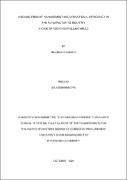| dc.description.abstract | The study centered on effect of inbound freight management and operational efficiency using a case study of Roofings Rolling Mills. The study was guided by the three objectives that is; to determine the effect of Carrier Management on operational efficiency, the effect of freight consolidation and optimization on operational efficiency and the effect of strategic partnership on operational efficiency of Roofings Rolling Mills. A cross-sectional survey design were used which enabled the researcher to collect detailed and in-depth data from Roofing Rolling mill staff. The researcher used questionnaire and interview guide to collect data from 32 and 3 respondents respectively. Research findings show that the respondents agreed that carrier management was high at Roofings Rolling Mills and it was revealed that, the extent to which carrier management predicts operational efficiency was low but the relationship between the two variables was statistically significant (R2 value 0.132 (13.2%), and Sig. value 0.041); r=0.465,sig.value=0.000. Findings also show that respondents agreed that freight consolidation and optimization was high at Roofings Rolling Mills and it was revealed that, the extent to which Freight consolidation and optimization predicts operational efficiency was low but the relationship between the two variables was statistically significant (R2 value 0.25(25%), and Sig. value 0.004); r=0.578,sig.value=0.000 and finally findings revealed that strategic partnership was high at Roofings Rolling Mills and it was revealed that, the extent to which strategic partnership predicts operational efficiency was low but the relationship between the two variables was statistically significant(R2 value 0.25(25%), and Sig. value 0.004) r=0.687,sig.value=0.000. In general, the extent to which inbound freight management predicts operational efficiency was low but the relationship between the two variables was statistically significant (R2 value 0.24 (24%), and Sig. value 0.004); r=0.662, sig.value=0.000. The researcher recommends that Roofings Rolling mills should continue adopting and implementing inbound freight management practices to effectively improve on their operational efficiency; the researcher therefore recommends the need for full management support/senior management sponsorship in order to tap more from the inbound freight management practices and a comparative study should be conducted regarding inbound freight management practices in another company with in manufacturing sector that is similar in terms of size in regard to areas for further study. | en_US |

